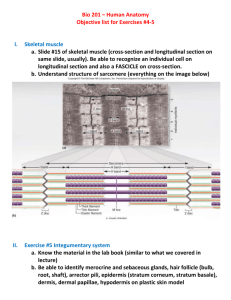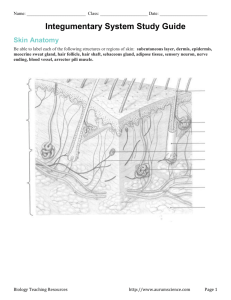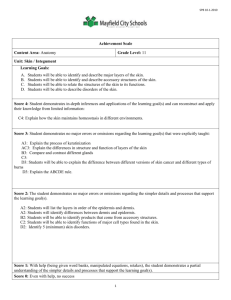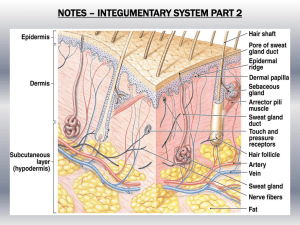INTEGUMENTARY
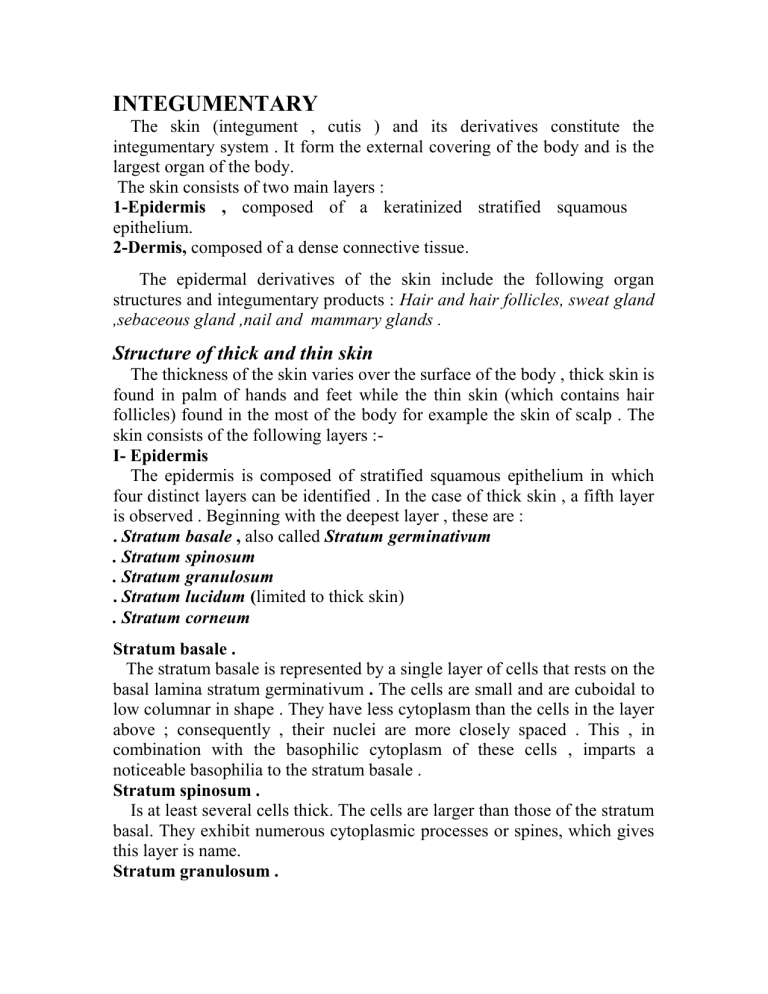
INTEGUMENTARY
The skin (integument , cutis ) and its derivatives constitute the integumentary system . It form the external covering of the body and is the largest organ of the body.
The skin consists of two main layers :
1-Epidermis , composed of a keratinized stratified squamous epithelium.
2-Dermis, composed of a dense connective tissue.
The epidermal derivatives of the skin include the following organ structures and integumentary products : Hair and hair follicles, sweat gland
,sebaceous gland ,nail and mammary glands .
Structure of thick and thin skin
The thickness of the skin varies over the surface of the body , thick skin is found in palm of hands and feet while the thin skin (which contains hair follicles) found in the most of the body for example the skin of scalp . The skin consists of the following layers :-
I- Epidermis
The epidermis is composed of stratified squamous epithelium in which four distinct layers can be identified . In the case of thick skin , a fifth layer is observed . Beginning with the deepest layer , these are :
. Stratum basale , also called Stratum germinativum
. Stratum spinosum
. Stratum granulosum
. Stratum lucidum ( limited to thick skin)
. Stratum corneum
Stratum basale .
The stratum basale is represented by a single layer of cells that rests on the basal lamina stratum germinativum . The cells are small and are cuboidal to low columnar in shape . They have less cytoplasm than the cells in the layer above ; consequently , their nuclei are more closely spaced . This , in combination with the basophilic cytoplasm of these cells , imparts a noticeable basophilia to the stratum basale .
Stratum spinosum .
Is at least several cells thick. The cells are larger than those of the stratum basal. They exhibit numerous cytoplasmic processes or spines, which gives this layer is name.
Stratum granulosum .
The stratum granulosum is the most superficial layer of the nonkeratinized portion of the epidermis. This layer varies from one to few cells contain numerous Keratohyaline granules hence the name of the layer.
Stratum corneum
Considered a subdivision of the stratum corneum by some histologists, is found only in thick skin. In the light microscope, it often has a refractile appearance and may stain poorly. This highly refractile layer contains eosinophilic cells in which the process of keratinization is well advanced.
The nucleus and cytoplasmic organelles become disrupted and disappear as the cell gradually fills with the intracellular protein keratin.
II- Dermis
Attachment of epidermis to dermis is enhanced by an increased interface between the tissues , one can recognize a division into two structurlly distinct layers .
The papillary layer , the junction between the dermis and epidermis as seen with the LM presents an extremely uneven boundary except in the thinnest skin. Section of skin cut perpendicular to the surface reveal numerous finger- like connective tissue protrusions, dermal papillae , that project into the under surface of the epidermis .When it contain a blood vessel then called vascular papillae , but when it contain a nerve ending (Meissner corpuscle) then it called nervous papillae .
The reticular layer , lies deep to the papillary layer; it characterized by thick , irregular bundles of collagen and the presence of more coarse elastic fibers.
The hypodermis, the subcutaneous connective tissue , is a looser connective tissue than the dermis . It lies deep to the dermis . The hypodermis contains variable amounts of adipose tissue .
BV : blood vessels , D : ducts of sweat glands , De : dermis , MC : meissners corpuscles
N : nerve bundles , PC : pacinian corpuscles
Skin appendages .
Hair and hair follicles
Hairs are present over almost the entire body , being absent only from the sides and palmar surfaces of hands .The hair follicle is responsible for the production and growth of hair ,coloration of the hair is due to the content and type of melanin .
The growing follicle expands at its base to form the pulp ,which invaginated by tuft of vascularized loose connective tissue called ,a dermal papilla. The outermost part of the hair follicle is a downgrowth of the epidermis designated the external (outer ) root sheath .The dividing cells in the
germinative layer of the matrix differentiation into the keratin –producing cells of the hair and the internal root sheath . The hair consist of a medulla, cortex , and cuticle , and the internal root sheath consist of a cuticle , Huxleys layer , and Henles layer . The follicle is surrounded by a connective tissue sheath to which the arrector pili muscle is attached.
Sweat glands
A simple coiled tubular structure composed of a secretory segment located deep in the dermis or in the upper part of the hypodermis and a directly continuous duct segment that leads to the epidermal surface. Sweat gland are classified on the basis of their structure and the nature of their secretion
.Two types of sweat glands are recognized:
1-Eccrine sweat glands.
2-Appocrine sweat glands.
Sebaceous Glands
The sebaceous glands producing oily substance , sebum .
Sebaceous gland Sweat gland
D: duct , SG: sweat gland , Seb: sebaceous gland
Nails
Nails are plates of keratinized cell containing hard keratin. The slightly arched fingernail or toenail, more properly referred to as the nail plate, rests
on the nail bed. The bed consists of epithelial cells that are continuous with the stratum basal and stratum spinosum of the epidermis. The proximal part of the nail, the nail root, is buried in a fold of epidermis and covers the cells of the germinative zone, the matrix.
The edge of the fold covering the root of the nail is the Eponychium or cuticle . Hyponchium is the free edge of the nail plate at the fingertip.
